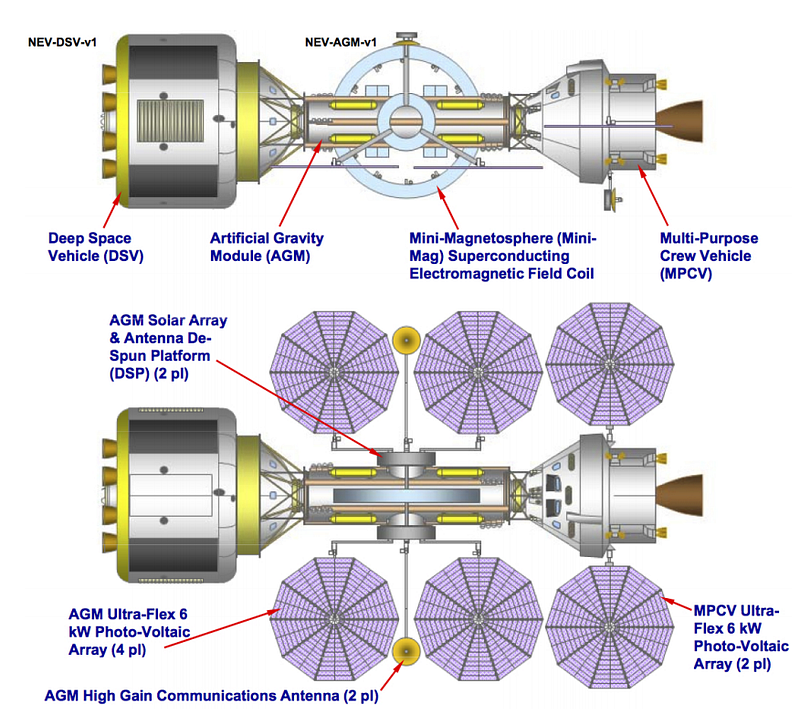New Mars Forums
You are not logged in.
- Topics: Active | Unanswered
Announcement
#1 2017-09-30 19:44:39
- SpaceNut
- Administrator
- From: New Hampshire
- Registered: 2004-07-22
- Posts: 30,242
Mars Base Camp
Lockheed Martins proposal for missions to Mars.

Mars. It’s humanity’s next giant leap. And we’re closer than we’ve ever been.
What will a human Mars mission look like? How can we keep astronauts safe, healthy and productive for a three-year journey into deep space? What can they discover when they get to Mars? How do we build a road map from today’s low-Earth orbit missions to our first interplanetary journey?
At Lockheed Martin, our job is to challenge ourselves and our industry teammates to drive the innovation that helps make those grand achievements possible - quickly, safely and affordably.
Mars Base Camp is Lockheed Martin’s vision for sending humans to Mars in about a decade. The concept is simple: transport astronauts from Earth, via the Moon, to a Mars-orbiting science laboratory where they can perform real-time scientific exploration, analyze Martian rock and soil samples, and confirm the ideal place to land humans on the surface in the 2030s.
Mars Base Camp lays out a proposed technology road map to support NASA’s journey to Mars. This is a mission designed to be led by NASA and its international and commercial partners.
The Mars Base Camp concept is built on a strong foundation of today’s technologies – making it safe, affordable and achievable:
Orion: The world’s only deep-space crew capsule, built with long-duration life support, deep space communications and navigation, and safe Earth re-entry capability. This is the mission Orion was born to do.
Space Launch System: Super heavy lift designed to send critical labs, habitats and supplies to Mars.
Habitats: Building on our NextSTEP research and NASA’s Deep Space Gateway architecture, deep space habitats will give astronauts room to live and work on the way to and at Mars.
Solar Electric Propulsion: Based on technology already in place on satellites, this advanced propulsion will pre-position key supplies in Mars orbit.How does Mars Base Camp work?
The major components of the architecture will be launched separately. Some are pre-positioned in Mars orbit ahead of time. Others are assembled in cis-lunar space for the journey to Mars. Six astronauts will launch on Orion, which serves as the heart of the Mars Base Camp interplanetary ship.

Mars Lander
As valuable as orbiting missions are for science and exploration, we’ll eventually look to leave the base camp and descend to the surface.
The Mars Base Cape surface lander concept is a reusable, single-stage lander capable of descending to the surface from Mars orbit using supersonic retropropulsion. Each surface mission could last two weeks with up to four astronauts, and return to the orbiting Mars Base Camp without surface refueling or leaving assets behind.
The lander uses Orion avionics and systems as its command deck and is powered by engines using liquid-hydrogen/liquid-oxygen propellant, both of which will be generated from water.

Offline
Like button can go here
#2 2017-10-01 14:12:54
- louis
- Member
- From: UK
- Registered: 2008-03-24
- Posts: 7,208
Re: Mars Base Camp
Will anyone take this seriously? LM have produced an over-complex plan in my view. I think they have underestimated the stress on crews from repeated sorties to the Mars surface. The health effects of repeatedly switching between zero and one third gravity are unlikely to be positive.
Space X's proposals are in my opinion far more impressive, as well as being much more straightforward. With LM you get the idea they don't really want to transfer human civilsation to Mars and are actually trying to limit human activity on the Mars surface!
Lockheed Martins proposal for missions to Mars.
https://lockheedmartin.com/content/lock … 016078.jpg
Mars. It’s humanity’s next giant leap. And we’re closer than we’ve ever been.
What will a human Mars mission look like? How can we keep astronauts safe, healthy and productive for a three-year journey into deep space? What can they discover when they get to Mars? How do we build a road map from today’s low-Earth orbit missions to our first interplanetary journey?
At Lockheed Martin, our job is to challenge ourselves and our industry teammates to drive the innovation that helps make those grand achievements possible - quickly, safely and affordably.
Mars Base Camp is Lockheed Martin’s vision for sending humans to Mars in about a decade. The concept is simple: transport astronauts from Earth, via the Moon, to a Mars-orbiting science laboratory where they can perform real-time scientific exploration, analyze Martian rock and soil samples, and confirm the ideal place to land humans on the surface in the 2030s.
Mars Base Camp lays out a proposed technology road map to support NASA’s journey to Mars. This is a mission designed to be led by NASA and its international and commercial partners.
The Mars Base Camp concept is built on a strong foundation of today’s technologies – making it safe, affordable and achievable:
Orion: The world’s only deep-space crew capsule, built with long-duration life support, deep space communications and navigation, and safe Earth re-entry capability. This is the mission Orion was born to do.
Space Launch System: Super heavy lift designed to send critical labs, habitats and supplies to Mars.
Habitats: Building on our NextSTEP research and NASA’s Deep Space Gateway architecture, deep space habitats will give astronauts room to live and work on the way to and at Mars.
Solar Electric Propulsion: Based on technology already in place on satellites, this advanced propulsion will pre-position key supplies in Mars orbit.How does Mars Base Camp work?
The major components of the architecture will be launched separately. Some are pre-positioned in Mars orbit ahead of time. Others are assembled in cis-lunar space for the journey to Mars. Six astronauts will launch on Orion, which serves as the heart of the Mars Base Camp interplanetary ship.
https://lockheedmartin.com/content/lock … 619666.jpg
Mars Lander
As valuable as orbiting missions are for science and exploration, we’ll eventually look to leave the base camp and descend to the surface.
The Mars Base Cape surface lander concept is a reusable, single-stage lander capable of descending to the surface from Mars orbit using supersonic retropropulsion. Each surface mission could last two weeks with up to four astronauts, and return to the orbiting Mars Base Camp without surface refueling or leaving assets behind.
The lander uses Orion avionics and systems as its command deck and is powered by engines using liquid-hydrogen/liquid-oxygen propellant, both of which will be generated from water.
Let's Go to Mars...Google on: Fast Track to Mars blogspot.com
Offline
Like button can go here
#3 2020-01-01 20:17:19
- kbd512
- Administrator
- Registered: 2015-01-02
- Posts: 8,432
Re: Mars Base Camp
SpaceNut,
I think it's time to take another hard look at this approach. A pair of small reusable landers and orbital SEP-powered LOX/LH2 plants is likely the best way to achieve our exploration goals before we start the colonization campaign. If we locate asteroids in the main belt with significant stores of water ices or we can obtain water from Phobos or Deimos, then we also have the resources required to conduct exploration between Mars and the main belt. I think an exploration campaign of 6 missions should be sufficient to locate the subsurface water resources we require to colonize Mars. This approach can also work for Venus.
I'm going to modify their approach and specify the use of atmospheric scoops and landers that use LOX/LCO because that propellant combination will work for both Mars and Venus and has a 290s to 300s specific impulse in a vacuum. The bulk density of liquid oxygen and liquid carbon monoxide is also much greater than LOX/LH2. We're still taking their water delivery vehicles, but that propellant will be used to get home instead of ascent / descent propellant for the landers.
Offline
Like button can go here
#4 2020-01-01 20:35:26
- SpaceNut
- Administrator
- From: New Hampshire
- Registered: 2004-07-22
- Posts: 30,242
Re: Mars Base Camp
Here is the link from the other topic which had the update to the base camp
https://www.lockheedmartin.com/content/ … ncepts.pdf
Lockheed Mars Base camp
https://spacenews.com/lockheed-martin-a … p-concept/
The mars lander looks like a mini starship...
The single-stage lander uses aerodynamics to reduce most of its velocity while descending to the surface. That can be done, the company said, using materials similar to that used on the high-speed SR-71 jet that are not ablative and do not require to be replaced after each mission.
Liquid oxygen/liquid hydrogen engines handle the rest of the landing as well as takeoff back to Martian orbit. The vehicle weighs 30 metric tons dry and can carry 80 metric tons of propellant, with a total delta-v, or change in velocity, of 6 kilometers per second from its engines.
The habitat and lander for mars still needs work but I think that using the payload shroud to encapsulate a beam sized habitat that can be removed from the top of a return to orbit vehicle is how to make the most out of the least amount of mass to mars.
Use a modified cygnus short stack can for the main area under the beam unit. Keep the cargo containers solar panels and add the retro engine landing to its normal base from the crewed dragon or make something simular.
The Beam fully collapsed fits inside the Dragon cargo truck.
https://en.wikipedia.org/wiki/Bigelow_E … ity_Module
https://www.space.com/19234-inflatable- … hotos.html
https://en.wikipedia.org/wiki/Cygnus_(spacecraft)
Dry mass Volume
3,400 kg (7,500 lb) 18.9 m3 (670 cu ft) (Std)
3,750 kg (8,270 lb) 27.0 m3 (950 cu ft) (Enh)
https://en.wikipedia.org/wiki/SpaceX_Dragon
Dimensions
Length 6.1 metres (20 ft)
Diameter 3.7 metres (12 ft)
Volume
10 m3 (350 cu ft) pressurized
14 m3 (490 cu ft) unpressurized
34 m3 (1,200 cu ft) unpressurized with extended trunk
Dry mass 4,200 kg (9,300 lb)
more dragon numbers here
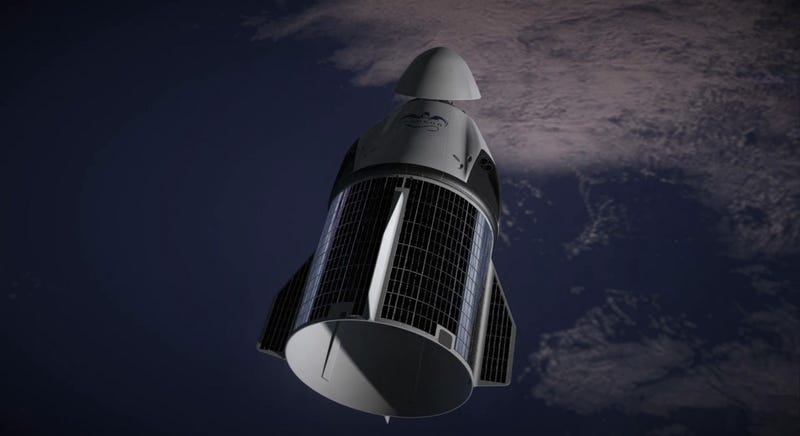
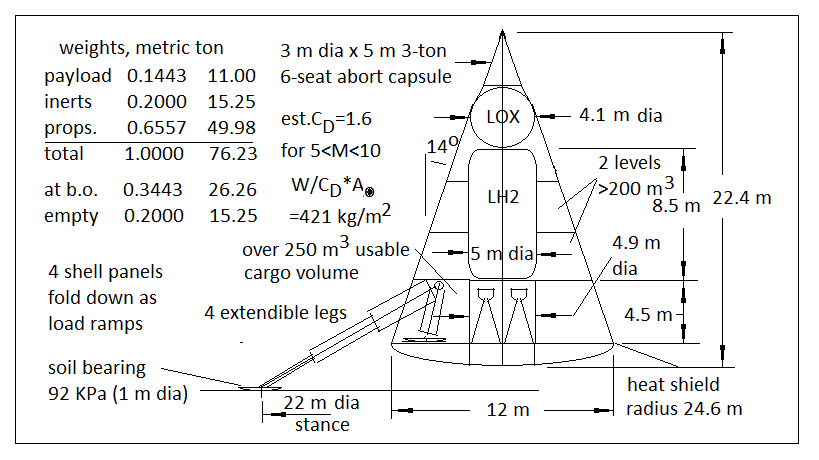
or something simular
Red Dragon and the Mars Direct
New Red Dragon Mission?
Reuseable Mars Lander, surface to orbit and back
here is the JPL document RED DRAGON-MSL HYBRID LANDING ARCHITECTURE FOR 2018
Here is the Mars Direct habitat from Robert Zubrin's first presentation 1990.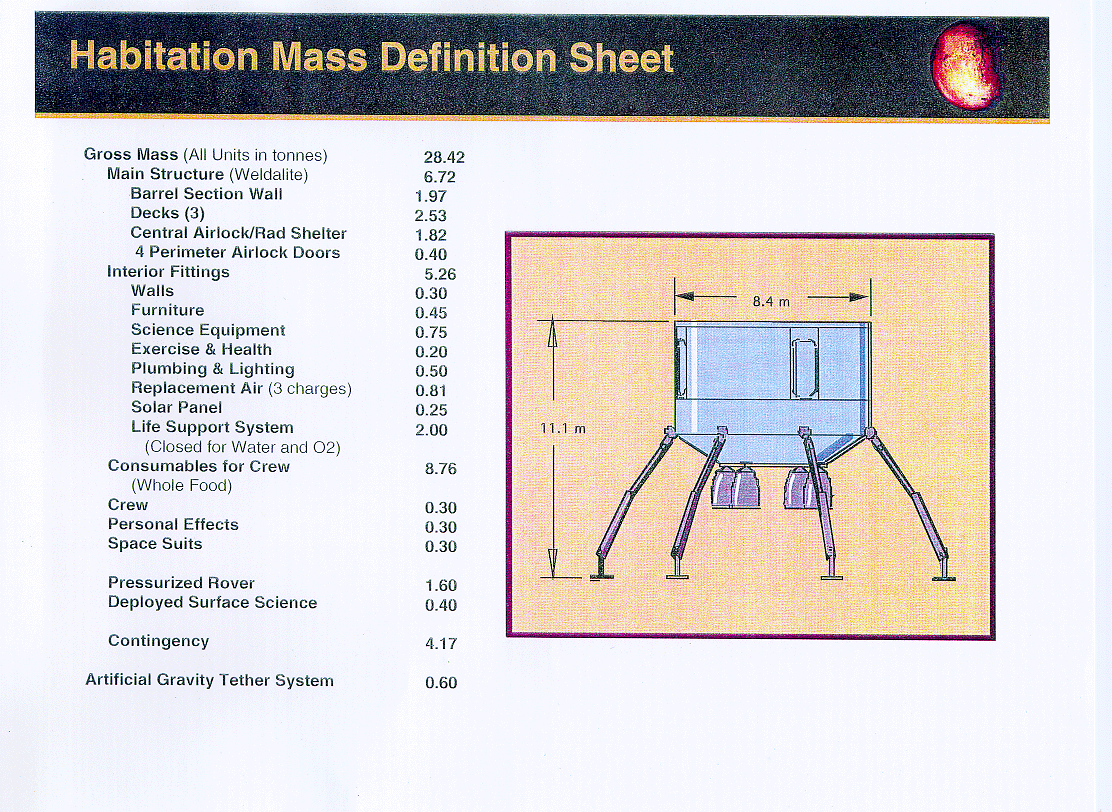
The marco polo unit will take care of return fuel use and oxygen maybe send 2 to preload the site we select to land at.
https://www.kiss.caltech.edu/workshops/ … anders.pdf
14.2 MT of Mars water per mission requires excavation of a Football field to a depth of 1.1 to 9.6 cm! (30% to 3% water by mass)
Making of the mission success the robotic missions need to peg down resources within the selected area for life support
Mars Sample Return (MSR) Mission
Offline
Like button can go here
#5 2020-01-01 21:20:01
- SpaceNut
- Administrator
- From: New Hampshire
- Registered: 2004-07-22
- Posts: 30,242
Re: Mars Base Camp
typical dragon layout of the internal diagram: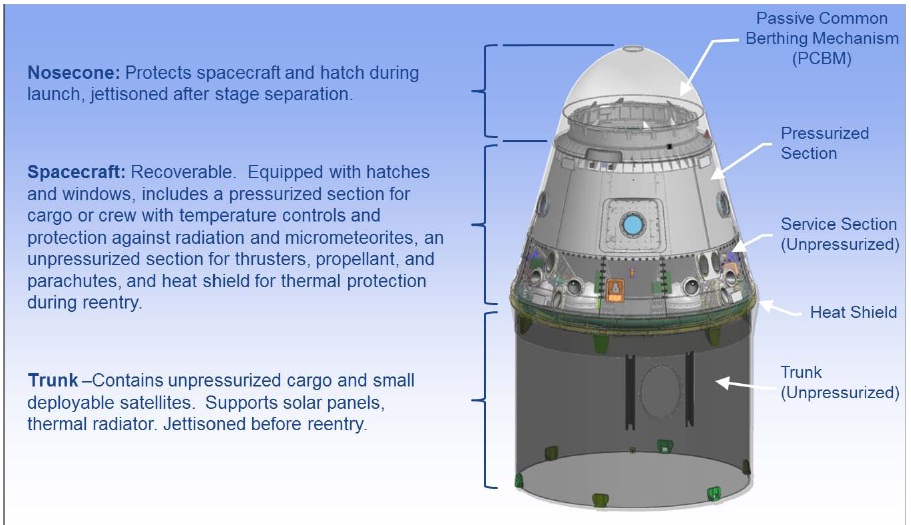
First post links and images are gone but the internet holds onto much....
https://en.wikipedia.org/wiki/Mars_Base_Camp
https://news.lockheedmartin.com/2017-09 … amp-Vision
https://www.lockheedmartin.com/en-us/pr … -camp.html
When I look at the image all I see is the lunar gateway station.
I agree that the SEP is how to move large mass to mars as indicated for both direction.
ION Drive a fast transit to Mars
ION Engines
Ion Propulsion
Forget NTR, SEP is the Future
Advanced Electric Propulsion System successfullu ttested.
NASA eyes ion engines for Mars orbiter launching in 2022
Nuclear Ion Propulsion
LOX - Ideal Solar Electric Propellent?
Storing highly ionized plasma at low density for ion drives.
462Ion Engines as Maneuvering Thrusters
Herakles xenon gas enabled spacecraft - just another ion-propulsion system
VASIMR - Solar Powered?
Variable Specific Impulse Magnetoplasma Rocket (VASIMR)
What of VASIMR - Discuss this system
VASIMR for LEO Launches? - What prevents it?
Vasmir update??? - any new news??
We do have many topics with SEP with in the discusions for Human mission and interplanetary which can be mined for data.
SLS JPL slide SEP rundown with more numbers here in the same topic
The center coupling is a node like on the ISS but lets dump the heavy orion as you could do the same with a modified cygnus design and dragon...
Modified mars lander mentioned in the other post would couple to the extra ports on the node.
Offline
Like button can go here
#6 2020-01-01 22:47:58
- SpaceNut
- Administrator
- From: New Hampshire
- Registered: 2004-07-22
- Posts: 30,242
Re: Mars Base Camp
Mission plan run down for risk mitigation
http://spaceref.com/mars/lockheed-marti … -camp.html
The basic shape is reminiscent of the old DC-X and DC-Y machines that Nasa worked on for rapid use until it had a leg go on landing...
The difficulty of landing for Mars
this contains the stability of height to mass center for leg spread for uneven landing area.
So a wide diameter means more stability for landing.
Of course this means knowing mass long before we ever get to using them to land with.
So a crew count per unit that lands for where we are is an issue for payload.
Crewman size and mass affects mission to mars
Minimum crew size for early Mars landings.
This is simular to the spreading out of resources across a common lander format as was done with Mars One
This starts the process of mission planning with basic building blocks from what is off the shelf.
Next up is science, experimentation and exploration of the site.
what we will do to plan such as food from a greenhouse... Indoor farming update
many more topics to add here
I think far from a first mission is the time to settle down for man to be able to stay but maybe late in the mission before returning home man could start.
As far as under ground the several meters is not what I would want either nor even a wall thickness as well. Since water and lead glass and a few other tricks can get us to that same degree of protection without all the dirt piled up on top of us.
Design of a Human Settlement on Mars Using InSitu Resources
Using augmented displays from outside cameras would be the norm for underground homes.
Nasa does do lots of funding for work to be performed in aspects of R&D for lots of things 
yes we have seen this but what its made from is a "mixture of basalt fiber extracted from Martian rock and renewable bioplastic (polylactic acid, or PLA) processed from plants grown on Mars. Basalt fiber is known for its superb tensile strength and it's comparable to carbon fiber and kevlar yet much simpler to produce."
Offline
Like button can go here
#7 2020-01-02 02:52:35
- kbd512
- Administrator
- Registered: 2015-01-02
- Posts: 8,432
Re: Mars Base Camp
SpaceNut,
I'm not a fan of these towering landers. I think a lifting body reentry vehicle with stub wings that contain thrusters for vertical landings is a better idea. In other words, something that has a landing gear configuration that more closely resembles that of an airliner than one of these rocket booster stages. Think of my concept as a lifting body sky crane with landing gear and engines in the tail for accelerating to orbital velocity. The CG of these rocket booster-like landers is way too high to be stable on anything but a nearly flat surface. The lifts or cranes required are also needless complications that a traditional aircraft landing gear arrangement would solve.
When compared to LOX/LCH4, the LOX/LCO propellant combination requires about 3 times as much propellant mass per unit of payload mass delivered to LMO, but the bulk density is better than LOX/LCH4 so you still wind up with smaller tanks. It's nothing to write home about, but the tanks are smaller (also heavier, which is not so good). The vehicle / payload mass fraction isn't that great, either. The input energy requirement for LOX/LCO manufacture is around 110MJ/kg of payload delivered to LMO and LOX/LCH4 is 460MJ/kg of payload delivered to LMO. In other words, more than 4 times as much power is required for the specific impulse increase of LOX/LCH4 over LOX/LCO. That doesn't seem like a good trade to me since we also have to expend even more energy on top of that 460MJ/kg figure to actually extract the 6t of water required to obtain each ton of Hydrogen that the LOX/LCH4 solution requires. Note that the 460MJ vs 110MJ figures are just the thermodynamic minimum energies required. Each chemical transformation will inevitably require more energy and thus more tonnage of equipment to complete the transformation.
LNG is really cheap and easy to come by here in America, but in terms of energy input and equipment tonnage delivered to Mars in order to get back to LMO or to Earth, it's pretty terrible for both exploration and colonization. SpaceX's colonization plan clearly doesn't place much of a premium on energy efficiency or useful tonnage delivered to Mars. I also fail to see how leaving a bunch of otherwise derelict aerospace hardware on the surface helps reduce the monetary cost of their stated goals. However, this is about exploration and efficiency matters even more since nobody will stay behind on Mars.
As ISPP complexity goes, the simplest way to make rocket propellant on Mars is to suck in the atmosphere to produce O2/CO from solid oxide electrolysis. The Mars 2020 rover's MOXIE experiment will actually test that technology. Assuming SOXE works, the Martian atmosphere could be one-stop shopping for LOX/LCO propellant and Argon for SEP propellant, all at 1/4 the energy input cost of LOX/LCH4. As a bonus, we'd have access to even better CO2 resources at Venus. If we use atmospheric scoops to make LOX/LCO from orbit, then we have a functionally limitless supply of propellant for our reusable landers. After the power infrastructure is in place on the surface and we can assure landing accuracy, then we can start trading "get back to orbit" propellant tonnage for "delivered cargo" tonnage. This won't work with any other propellant combination and we'll end up needlessly shipping and storing H2O or LH2 or LCH4 instead of using what Mars and Venus both have in their atmospheres.
While LOX/LCO is a mediocre rocket propellant combination, it's good enough to get the job done and doesn't require shipping nearly so much equipment to Mars. Development work to obtain LOX/LCO is limited to a single fuel cell system which will presumably be tested aboard the Mars 2020 rover. Nearly all of the power budget is devoted to ISPP, but LOX/LCO cuts that to 1/4 of what LOX/LCH4 requires after obtaining the water from Mars. There are significantly fewer potential failure modes with LOX/LCO than LOX/LCH4, especially since no mobile robotic or crewed mining equipment is required. I've little doubt that we can design a robust Sabatier reactor, given enough time and money, but robust AI-enabled autonomous mining vehicles are a giant question mark. Furthermore, even if no usable water supply or merely insufficient quantity of water is available near the landing area, none of that impacts the ability to return to orbit. Since the "gear ratio" for shipping a ton of anything from Earth to the surface of Mars is so high, it makes a lot of sense to keep as much stuff as we can in orbit and only take whatever is actually required to explore to the surface of the planet.
So, I would say we take both water and LCO2, which is also storable under pressure, which we then transform in-situ into propellants, as required, using 12 hours of full Sun, which is what we receive in orbit, to make whatever propellants are required for surface exploration. After sites with ample water ices have been located, then we can think about colonization efforts. Even then, it still makes more far sense from an energy expenditure perspective to just use the Martian atmosphere as our propellant source. There's a premium on delivered tonnage, power, and water. Whatever water we can obtain is precious and there are many other uses for that water besides rocket propellant, no matter how much is available, especially for a fledgling colony that needs to rapidly become self-sustaining.
Offline
Like button can go here
#8 2020-01-02 08:45:31
- tahanson43206
- Moderator
- Registered: 2018-04-27
- Posts: 23,888
Re: Mars Base Camp
Post #7 by kbd512
http://newmars.com/forums/viewtopic.php … 73#p163773
SearchTerm:CarbonMonoxide In this post kbd512 presents an argument for using carbon monoxide instead of methane for rocket fuel
He also introduces (or reminds the reader) of the option of scooping propellant input gas from the atmosphere of Venus.
(th)
Offline
Like button can go here
#9 2020-01-02 11:42:23
- SpaceNut
- Administrator
- From: New Hampshire
- Registered: 2004-07-22
- Posts: 30,242
Re: Mars Base Camp
http://www.marspapers.org/paper/Muscate … 3_pres.pdf
Atmospheric Processing Module for Mars Propellant Production
Supply 88 g CO2/hr at 50 psia to the Sabatier reactor
Convert CO2 to 31.7 g CH4/hr and 71.3 g H2O/hr
MARCO POLO production goals of 444 g CH4/day and 1.77 kg O2/day (50% of O2) for a total of 2.22 kg propellant/day
The lander will operate on a 14 hour day/10 hr night cycle with the control centers monitoring the autonous onboard software and operations.
https://pdfs.semanticscholar.org/f060/2 … 13167b.pdf
Prototype Development of an Integrated Mars Atmosphere & Soil Processing System
The dryer is capable of heating simulant to 500oC using either external heaters, internal heaters or a combination of both. Each heater group can provide up to 4 kW of power.
MARCO POLO lander electrolysis module will incorporate two lower pressure Proton Exchange Membrane (PEM) 12-cell liquid-anode feed electrolysis stacks for water electrolysis.
The two Giner electrolyzer stacks can process 522 g/hr of deionized water at 3KW. The stacks can operate up to 695 g/hr but the power consumption was too much for the demo to accomadate.
The Power production duties for the demo is split between a 13KW off lander fuel cell for daytime operations (to simulate power from a solar array) and the 1KW fuel cell located on the lander for night time operations.
The ability to make Basalt tanks has been answered for mars
Basalt fiber
Here is a list from the Human folder for topics that we have which relate:
Mars Insitu Fuels made from atmosphere, regolith, water
Carbon Monoxide - a way to power Mars?
Moxie and only Moxie
Revisiting Supersonic CO2 Compressors for Mars EDL
LOX/CO2-Diborane rocket for reusable landing boats
Here is a list from the Interplanetary transportation folder for topics that we have which relate:
LOX-Acetylene/CO rocket by Landis for a complete ISPP
Water/CO2 NERVA for Mars
Chem. Rockets - Using Ozone with oxygen as an oxidizer
Here is a list from the Unmanned probes folder for topics that we have which relate:
Mars Co2 or other compressed Gas Hopper rocket
Here is a list from the Life support systems folder for topics that we have which relate:
Compressed gas energy storage.
Atmospheric Separations
Carbon and Carbon Monoxide
CO2 Sublimation Heat Engine
Solar Heliostat System with Molten Salt Bath, and Liquid CO2 Method.
Supercritical CO2 - Useful technology?
Solar Mirror CO2 to Oxygen Converter
Liquid CO2 for clothes washing
C02 as a working fluid.
The Liquid co2 borders on boiloff of hydrogen discussion. Long-duration cryogenic storage of propellant and life support liquids is an enabling technology within the critical path of nearly all envisioned human planetary missions.
Microgravity Zero Boiloff Tank experiments provide data for Pressure Control Systems
Offline
Like button can go here
#10 2020-01-02 20:35:23
- SpaceNut
- Administrator
- From: New Hampshire
- Registered: 2004-07-22
- Posts: 30,242
Re: Mars Base Camp
5 Mars Mission Radiation Shield Ideas Win NASA Challenge

Lockheed's Prototype Habitat Plans for NASA's Lunar Orbiting Deep Space Gateway Lockheed Martin was one of them, and this week the company released some details on plans for their full-scale prototype, which they hope to complete over the next 18 months.
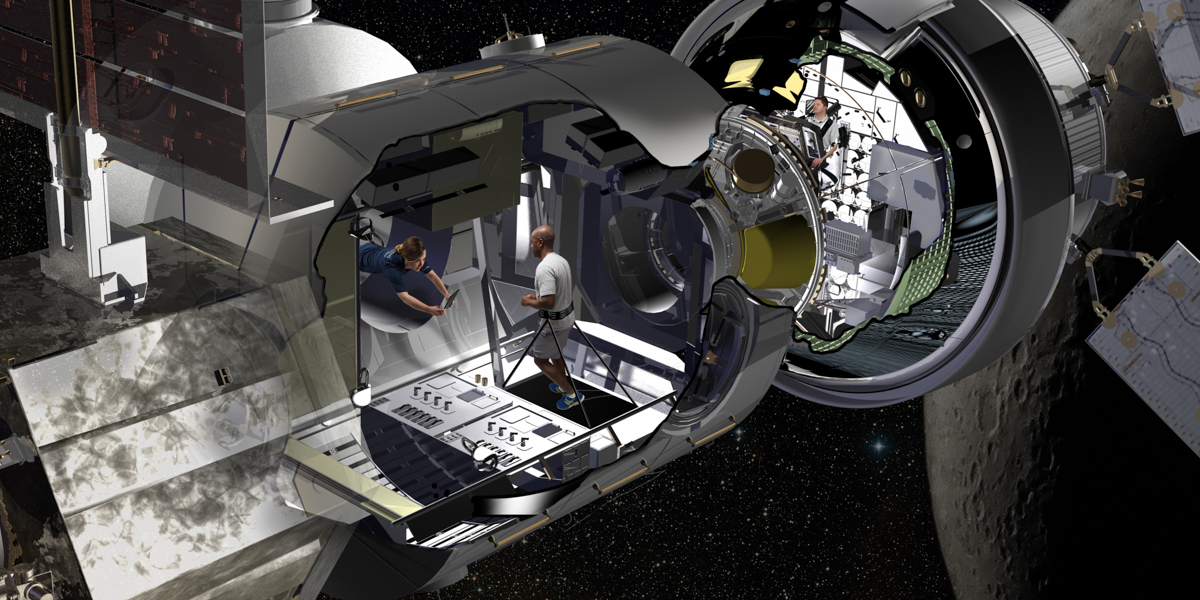
“The deep space gateway would have a power bus, a small habitat to extend crew time, docking capability, an airlock, and serviced by logistics modules to enable research,” says NASA.
“The propulsion system on the gateway mainly uses high power electric propulsion for station keeping and the ability to transfer among a family of orbits in the lunar vicinity.
The three primary elements of the gateway, the power and propulsion bus and habitat module, and a small logistics module(s), would take advantage of the cargo capacity of SLS and crewed deep space capability of Orion.
An airlock can further augment the capabilities of the gateway and can fly on a subsequent exploration mission.
Building the deep space gateway will allow engineers to develop new skills and test new technologies that have evolved since the assembly of the ISS.”
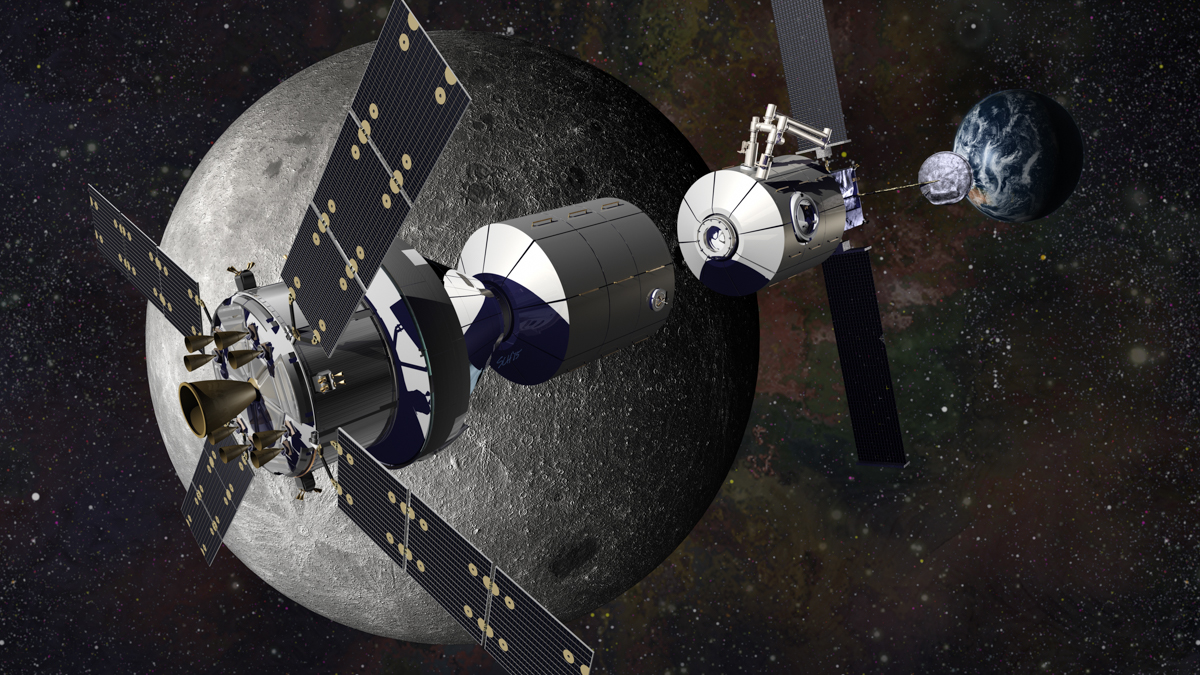
Other mission planning archetecture:
Boeing's plan for Mars
baseline mission information of plan
Past mission plan by kbd512 launching using the Falcon Heavy
Offline
Like button can go here
#11 2020-01-02 21:33:13
- kbd512
- Administrator
- Registered: 2015-01-02
- Posts: 8,432
Re: Mars Base Camp
SpaceNut,
We need miniature space stations with artificial gravity, adequate radiation shielding, and electric propulsion to cut the enormous fuel bill to something manageable in order to deliver astronauts and eventually colonists to Mars in good physical condition. The upper stage of a chemical rocket that must remain light enough to achieve orbit and perform vertical landings on unimproved surfaces can't provide those things in a practical manner because the design requirements are in direct opposition to each other. The lander really needs to be a separate technology.
It doesn't much matter if our miniature space station gets there a little slower than by using chemical propulsion if it allows the astronauts or colonists to live in space or on the surface of the planet indefinitely and with the added protections that an orbital space station provides if something goes seriously wrong, which could be something as simple as abrasive volcanic ash destroying the seals in airlocks. I only look at what NASA and Lockheed-Martin are doing as prototypes that other companies like Bigelow Aerospace and SpaceX can then modify or scale up, as required. However, we need some proof of concept demonstrators to retire risk and build operational experience.
Offline
Like button can go here
#12 2020-01-03 13:04:51
- SpaceNut
- Administrator
- From: New Hampshire
- Registered: 2004-07-22
- Posts: 30,242
Re: Mars Base Camp
Three modules were built by the Italian Space Agency (ASI), Leonardo, Raffaello and Donatello...which are simular to the ones which are part of the gateway concept.
http://www.nasa.gov/externalflash/ISSRG/pdfs/mplm.pdf

Its funny that long before the Falcon Heavy was flying we were working on the scaled back mission of Mars Semi-Direct with Falcon with post #16 has many of the data points of planning.
This is the landing of mass to surface and such we can only stretch the limits a little without changing design.
Landing on Mars
We know that diameter for heatshield aids in rising the payload to mars, it gives a wider base to landing legs for stability, we know that its easier to get to the ground with payload that needs to be unloaded to build the base with.
We also know that parachutes get near useless at speeds created with larger mass plumeting to the surface on course to land safely, We know that monitoring distance to the surface is critical, that engines are hard to start in the slipstream of mars air hitting the heatshield but can start with the canted draco engine design just fine.
These are simplest of things to change for a mars lander...
AG or artificial gravity post that shows effected area to body
GW post #32 gives
56 m radius at 4 rpm = 1 full gee. Gee is proportional to radius^1 and spin rate^2, so 8 rpm at 14 m radius is also 1 gee.
Offline
Like button can go here
#13 2020-01-03 15:38:34
- SpaceNut
- Administrator
- From: New Hampshire
- Registered: 2004-07-22
- Posts: 30,242
Re: Mars Base Camp
If we do not have 20 cm of water content for radiation there may be the chance for this
post reference page which GW does quote...
Radiation amount type risk mitigation
I suspect that recovery or recycling will be low on the first mission concepts but where it applies Mars Homesteads colony plan to recycle waste
Much of the base camp comes from Deep Space Gateway; a bad joke by NASA? or LOP as some at Nasa call it.

Offline
Like button can go here
#14 2020-01-03 19:20:52
- SpaceNut
- Administrator
- From: New Hampshire
- Registered: 2004-07-22
- Posts: 30,242
Re: Mars Base Camp
The mars landing EDL profile
http://exrocketman.blogspot.com/2018/09 … -mars.html
Retro-propulsion is necessary from the moment hypersonics end at about 0.7 km/s speeds. Altitudes are on the order of only 5 km, so that impact is but seconds away, unless retropropulsion is on the order of 3-4 gees.
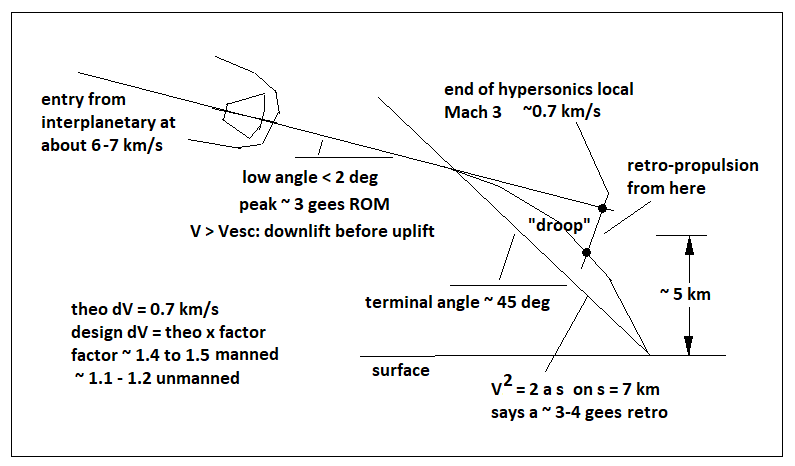
retro-propulsion lander that is one stage and not reusable, can have at most a payload fraction of about 50%, using long-term storable propellants, such as MMH-NTO.
Of course clean sheet would take longer and even thou the Red Dragon is out as well.
The crewed Dragon we have not looked at yet but it may have promise and the cargo Dragon is run here http://exrocketman.blogspot.com/2017/03 … -data.html
This is one technology that we are waiting to see if its ever going to see the light of day for even higher payload mass delivery to mars surface:
Exploring the Solar System? you may need to pack an umbrella. ADEPT is a foldable device that opens to make a round, rigid heat shield, called an aeroshell.

ADEPT's first flight test is scheduled for Sept. 12 from Spaceport America in New Mexico aboard an UP Aerospace suborbital SpaceLoft rocket. ADEPT will launch in a stowed configuration, resembling a folded umbrella, and then separate from the rocket in space and unfold 60 miles above Earth.
The test will last about 15 minutes from launch to Earth return. The peak speed during the test is expected to be three times the speed of sound, about 2,300 miles per hour.
That is not fast enough to generate significant heat during descent, but the purpose of the test is to observe the initial sequence of ADEPT's deployment and assess aerodynamic stability while the heat shield enters Earth's atmosphere and falls to the recovery site.
This umbrella-like mechanical aeroshell design uses flexible 3D woven carbon fabric skin stretched over deployable ribs and struts, which become rigid when fully flexed. The carbon fabric skin covers its structural surface, and serves as the primary component of the entry, descent and landing thermal protection system.
"Carbon fabric has been the major recent breakthrough enabling this technology, as it utilizes pure carbon yarns that are woven three-dimensionally to give you a very durable surface," said Wercinski. "Carbon is a wonderful material for high temperature applications."
The next steps for ADEPT are to develop and conduct a test for an Earth entry at higher "orbital" speeds, roughly 17,000 miles per hour, to support maturing the technology with an eye towards Venus, Mars or Titan, and also returning lunar samples back to Earth.
Offline
Like button can go here
#15 2020-01-04 18:04:44
- kbd512
- Administrator
- Registered: 2015-01-02
- Posts: 8,432
Re: Mars Base Camp
SpaceNut,
If we actually fly a miniature space station in lunar orbit for 6 months, that'll be more practical deep space flight experience than has ever been demonstrated by anyone at any time in history. If we can do that without replenishment of consumables or replacement of critical subsystems such as the life support equipment, then we've demonstrated the ability to survive a transit to Mars. If we can do that for 2 years, then we've also demonstrated the ability to execute a fly-by mission to Mars or Venus. Executing those missions would demonstrate more real commitment and serious progress towards a Mars landing than all the speeches and PowerPoint proposals in the world could ever demonstrate.
Our legacy flight-rated hardware such as a Cygnus cargo module, an ISS node module, RL-10 powered Centaur upper stages with IVF, when combined with the new ATK arrays and 200kW ion engines are entirely sufficient for that purpose. Let's do this mission, discover our weak points related to systems failures, fix all of the design flaws, and move on to Mars missions using existing hardware. A Centaur-enabled Falcon Heavy is entirely sufficient for exploration purposes. We'll continue using on-orbit assembly, as required, just as we did to construct ISS, and use lift / throw / let it go to send all hardware to wherever it needs to go.
Offline
Like button can go here
#16 2020-01-04 19:59:13
- SpaceNut
- Administrator
- From: New Hampshire
- Registered: 2004-07-22
- Posts: 30,242
Re: Mars Base Camp
To take the full assembly to the moon for ion station keeping we will need a RL-10 powered centaur stage to make earth departure happen as we do not want the crew looping around in the earths rediation belt if we are traveling on board the gateway vehicle.
As for coming back to LEO we can use the ion drive engine but we still do not want to lurk to long for the same reason on the way back.
So now we have a lunar space station where we will have issues with resupplying it as we did not develope a means to get from earth to the station quickly. The lunar station could be added onto but at what cost from earth once its in lunar orbit.
Sure we now have lots of practice with a station on the move with hopefully AG and radiation sheltering but thats about all we get with recycling for life support functions.
Offline
Like button can go here
#17 2020-01-05 21:21:25
- SpaceNut
- Administrator
- From: New Hampshire
- Registered: 2004-07-22
- Posts: 30,242
Re: Mars Base Camp
Much of the base camp is contained in this work..
repost
Lockheed was using the existing protyes that were left over from the ISS which were just hanging around and these were built by the same Italian company that makes the cygnus for ATK that is now Northrop Grumman Innovation Systems... NASA Awards Contract to Northrop Grumman for Lunar Gateway Habitat Module
I sure would change horses as well since how slow Boeing and Lockheed are going with SLS to a proven performer....
NASA Awards Contract to Northrop Grumman for Lunar Gateway Habitat Module with production and tooling resources capable of meeting the 2024 deadline.
two habitation module prototypes: one seven meters long and 4.4 meters in diameter, and the other six meters long and three meters in diameter.
https://www.nasa.gov/sites/default/file … _Orbit.pdf
Cygnus Beyond Low-Earth Orbit – Logistics and Habitation in Cis-Lunar Space
pg 14 shows the standard configurations of what is normally built.
Not needed on the cygnus is its normal propulsion unit which has a gross mass of 1,800 kg with thrusters using the hypergolic propellants hydrazine and nitrogen tetroxide and is capable of producing up to 4 kW of electrical power via two gallium arsenide solar arrays.
Offline
Like button can go here
#18 2020-01-05 22:26:51
- SpaceNut
- Administrator
- From: New Hampshire
- Registered: 2004-07-22
- Posts: 30,242
Re: Mars Base Camp
This is how a cygnus normally looks packed away for launch.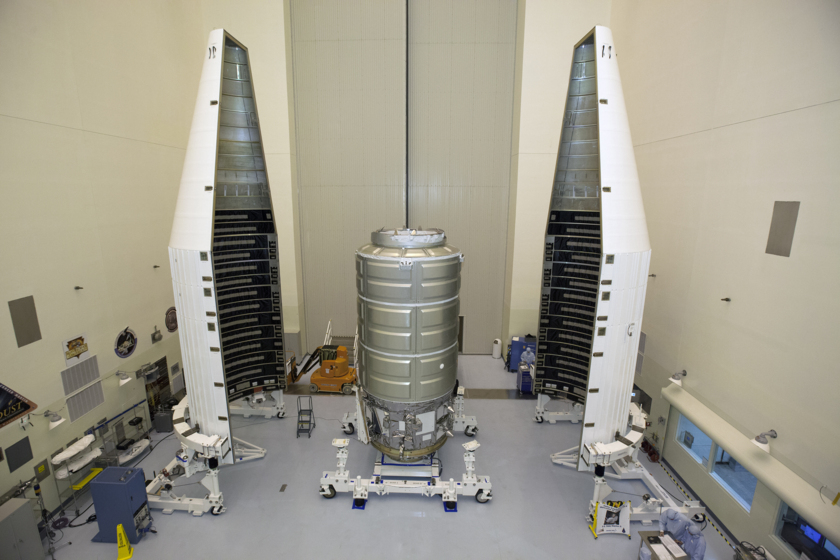
1. There does appear to be plenty of room over the cygnus for a BEAM to be attached fully collapsed. Make the cygnus with the standard side hatch as well and supply a ladder to attach to the unit once the outer shroud is removed on mars.
Of course each cygnus unit lander for mars would contain a truck for solar panels, the heat sheild and retro rockets to make the landing possible on a set of legs for a mars landing.
2. For the crewed version leave out the inflateable and add in tunnel connection materials to get the units linked together to save on compression and decompression exits. Add on an outer air lock to the crewed unit that is stowed over head on the cygnus lander.
3. For the return home ship landing use the short length cygnus and make the truck larger for the fuel and engines needed to get back to orbit. This would have a light mass open rover for exploration.
4. For the return home it would rendevous with the waiting mission home care package of goods to finish the trip back stocked in the extra large cygnus sent there with ion propulsion.
5. If you do not want to do insitu refueling send down a fuel tanker for the return home ship to fuel up with.
6. use all of the landing payload shrouds to make more structure protection.
Offline
Like button can go here
#19 2020-01-06 19:15:51
- tahanson43206
- Moderator
- Registered: 2018-04-27
- Posts: 23,888
Re: Mars Base Camp
For SpaceNut ...
The link below is from Lizard King of luf.org
It applies to more than one topic, so I'll be posting it where it seems to fit.
https://www.sciencemag.org/news/2019/09 … iquid-fuel
In this case, a Mars Base Camp would use this technology to capture water vapor and CO2 from the atmosphere.
(th)
Offline
Like button can go here
#20 2020-01-06 20:56:01
- SpaceNut
- Administrator
- From: New Hampshire
- Registered: 2004-07-22
- Posts: 30,242
Re: Mars Base Camp
An application for water would come from a dome over a soil sample to heat from solar concentration under the robotic unit. The heat would cause the ground to warm and the moisture would be released for capture at the top of the dome to enter the unit along with the co2 in the dome. The unit would then move and do this once more as it processes the captured materials to make into fuel. At the bottom of the dome would be a software surface to make a semi seal for a return air blower to send back what is not processed from the previous intake.
Now to go research the MOF materials as to if these can be made on mars or brought.
Offline
Like button can go here
#21 2020-01-07 19:53:56
- SpaceNut
- Administrator
- From: New Hampshire
- Registered: 2004-07-22
- Posts: 30,242
Re: Mars Base Camp
Here Is NASA's Plan for a Space Station That Orbits the Moon.
This new base would provide humanity with its first foothold to future human missions to the moon, Mars, and beyond with it starting with this.
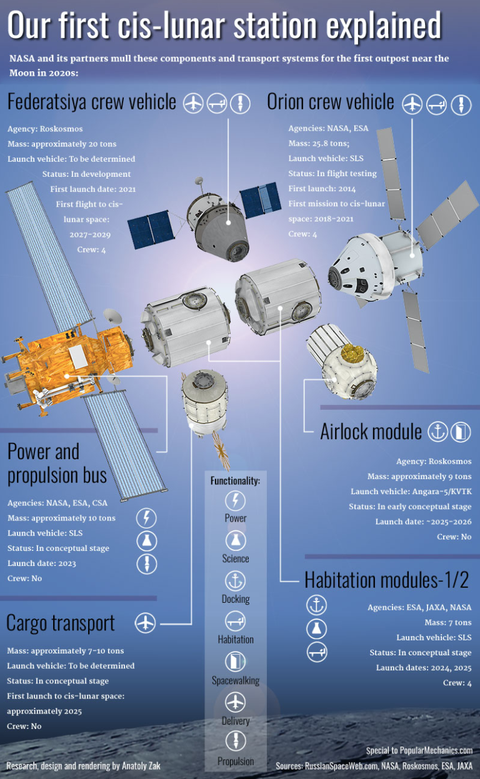
Of course man is taking a big step back into space to just orbit the moon and to build on the technology that will allow for man to journey even further away.
Taking Cygnus to the Next Level
This was a proposal from when ATK Orbital was putting us towards making that step![NextSTEP_thmb_111b0f84-cbbb-4b9f-a8e1-7376b5f6c532-prv.jpg]](https://s3.amazonaws.com/cms.ipressroom.com/295/files/201807/5b503fafa1383540b0f1ceb1_NextSTEP_thmb/NextSTEP_thmb_111b0f84-cbbb-4b9f-a8e1-7376b5f6c532-prv.jpg])
With this coming from the bought out pair
Offline
Like button can go here
#22 2020-01-11 09:30:32
- SpaceNut
- Administrator
- From: New Hampshire
- Registered: 2004-07-22
- Posts: 30,242
Re: Mars Base Camp
Eight engines would fire at full thrust in a Dragon launch abort scenario.
Rated for 25 seconds total burn time, using 1388 kg of propellant. N2O4/MMH http://www.astronautix.com/n/n2o4mmh.html
Thrust: 73.00 kN (16,411 lbf). Specific impulse: 235 s.
This is the storable which can be something for a long term goal to manufacture but for now its methane and oxygen.
599 pages
http://strategic.mit.edu/docs/PhD_2016_do.pdf
Towards Earth Independence – Tradespace Exploration of Long-Duration Crewed Mars Surface System Architectures
They will also be facing extreme temperature changes on Mars because of its location near the equator, where summer sun causes temperature swings from 21°C (70°F) to as low as -73°C (-100°F) at night!

Where we have been
look out another 598 pager
https://www.nasa.gov/sites/default/file … 6-ADD2.pdf
Human Exploration of Mars Design Reference Architecture 5.0
The 2 stage MAV is on pg 364 planned for a crew of 6
A crew of 2 could be done on a much smaller scale with current equipment.
Offline
Like button can go here
#23 2020-01-12 21:49:32
- SpaceNut
- Administrator
- From: New Hampshire
- Registered: 2004-07-22
- Posts: 30,242
Re: Mars Base Camp
After going through the entire document much of the DRA5 mission plans are still being pushed for mars and the gateway.
Nasa want 6 crew with a 40mt lander but the would drop it down to 20mt with a crew of 4
I would suppect that a crew of 2 would be with current technology at the 10 mT landers which the Red Dragon was at that level.
http://www.ssdl.gatech.edu/sites/defaul … 6-0219.pdf
A High-Heritage Blunt-Body Entry, Descent, and Landing Concept for Human Mars Exploration
Scaled-up RS-72 engine; assumed Isp=338 Mono-Methyl Hydrazine (MMH) and Mixed Oxides of Nitrogen (MON-25) was for a second stage return to orbit.
http://rascal.nianet.org/wp-content/upl … rpoint.pdf
Human Mars Lander Design for NASA’s Evolvable Mars Campaign
EDL large mass made possible with the hypercone inflateable heat shield concentric doughnuts (HIAD – Hypersonic Inflatable Aerodynamic Decelerator) to send down 3 different landers for a crew of 6.
Offline
Like button can go here
#24 2020-02-19 21:40:52
- SpaceNut
- Administrator
- From: New Hampshire
- Registered: 2004-07-22
- Posts: 30,242
Re: Mars Base Camp
the mars lander in the drm5.0 table 1-1 has the crew as 6 or 4
so scaling the table for a crew of 2 plus cut the size fo the habitat mass in half:
2 crew 10 t lander payloads with a ship that has a mass of 10 t - 15 t wet or less
can the item be split up yes or no and for how many of it for payload count.
Crew Consumables 1 2,647 Yes
Science 1 400 Yes
Robotic Rovers 2 200 No
Drill 1 250 No
Unpressurized Rover 1 200 No
Pressurized Rover 1 7,500 No
LOX Transfer Cart 1 400 No
Habitat 1 9,935 No
Stationary Power System 2 7,800 No
ISRU Plant 1 1,230 No
Offline
Like button can go here
#25 2020-08-20 18:39:17
- SpaceNut
- Administrator
- From: New Hampshire
- Registered: 2004-07-22
- Posts: 30,242
Re: Mars Base Camp
bump
Offline
Like button can go here
